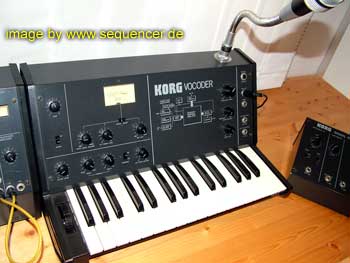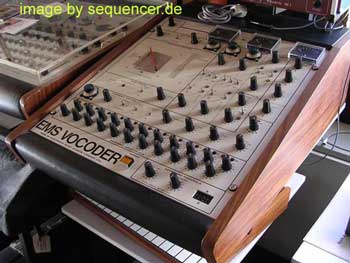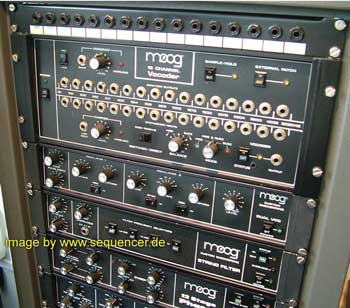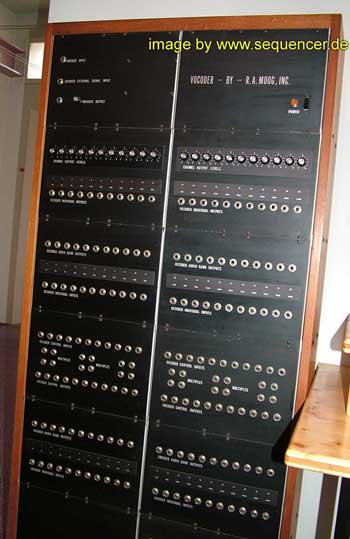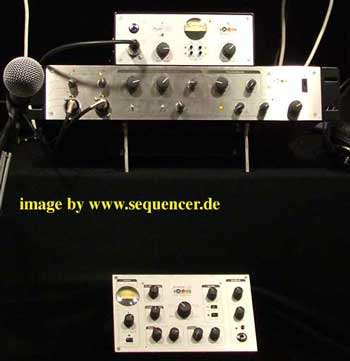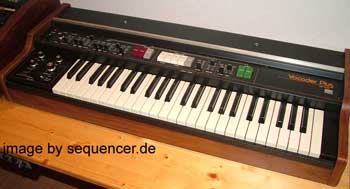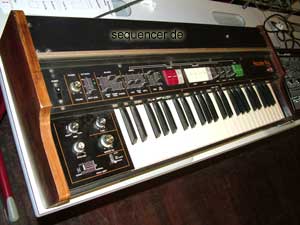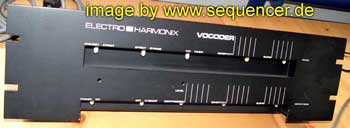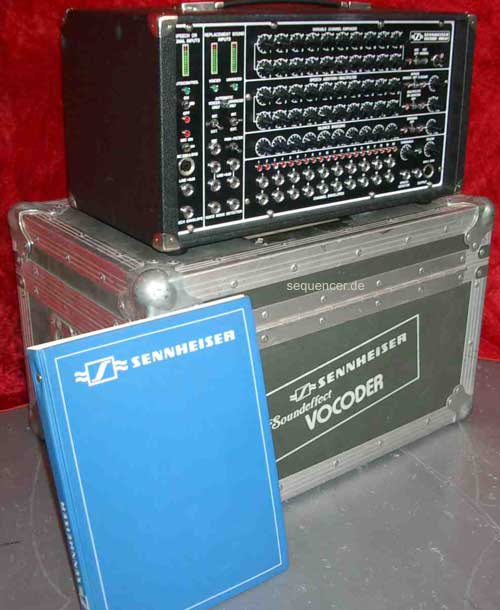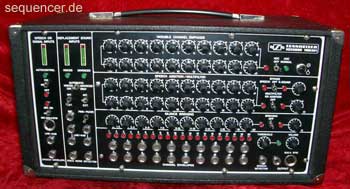Vocoder: Unterschied zwischen den Versionen
KKeine Bearbeitungszusammenfassung |
|||
| (4 dazwischenliegende Versionen desselben Benutzers werden nicht angezeigt) | |||
| Zeile 1: | Zeile 1: | ||
Voice Coder | Voice Coder [[category:List]][[category:Hardware]][[category:Sound Synthesis]] | ||
==Related Links / Erklärung / Explanation== | |||
*http://sequencer.de/software_synthesizer/NI_vokator.html | |||
*http://sequencer.de/synthaudio/synthesizer-grundlagen.html#vocoder | |||
==history== | ==history== | ||
| Zeile 12: | Zeile 18: | ||
Voice Coder = Vocoder - analyses frequency ranges from the original and transforms it to another frequency section (vocoder=voice encoder decoder) | Voice Coder = Vocoder - analyses frequency ranges from the original and transforms it to another frequency section (vocoder=voice encoder decoder) | ||
And most poeple who tell about vocoders basically mean "there's some tech gadget mangling the voice" but - in fact it's often a harmonizer (indie / pop music / song writer), auto tune (Mainstream Pop), or just a reverb / distortion (EBM/Industrial) - but vocoders are those sounding like ... the Kraftwerk Robot thing and are sort of a singing synthesizer - it's basically checking a few frequency bands, exchanging those bands and playing it back replacing the natural sound source by a synthesizer (mostly pads with certain amount of upper harmonics like rich string pads) to reproduce consonants and s and f noises (which can be coloured noise but as a whole it must be something tonal if you want to play melodies). so there's an analyzing part and a synthesizing part, one that transforms the microphone (or drum loop …) signal into those band filtered 8 or 16 bands (sometimes more) and so to say "sorts" out which frequency group plays a role in your stream of speach / singing.. and afterwards that synthesizer voice plays it back, maybe you have assigned those frequency bands to other bands, so this makes it sound a bit different - note - this was made to chipher encode signals - so this is just a bit simpler because you still want something that makes sense "musicially". so - here you go - the oscillator is that synth carrier signal and will play as much harmonics as that back to the designated band.. and now you have it - we are the robot'sssss... some original direct signal will help to understand what your robot is saying.. | |||
==deutsch== | ==deutsch== | ||
| Zeile 87: | Zeile 96: | ||
*Electronica EM-26 (from russia), no pic. | *Electronica EM-26 (from russia), no pic. | ||
Aktuelle Version vom 22. Mai 2020, 11:01 Uhr
Voice Coder
Related Links / Erklärung / Explanation
- http://sequencer.de/software_synthesizer/NI_vokator.html
- http://sequencer.de/synthaudio/synthesizer-grundlagen.html#vocoder
history
Homer Dudleys Voder is one of the first made (late 1930ies/ very early 1940s) (the vocoder was invented for the war (again) to encode and decode spoken messages..) Voder Info: http://www.blogigo.de/Elektrogemeinschaft/200507
Note: Kraftwerk used a machine called Votrax (Siemens), its a phonetic Generator, so it is no Vocoder.. but of course they also used vocoders (a lot)..
english
originally made for coding Voice send it by wire and decode it again (milltary use) but now it is used in music. it is a Filterbank (synthesis and analysis part) with 8 or more bands and a a voiced / unvoiced detector. each band will be "scanned" by an envelope follower witch only listens to a certain range of audio. the synthsis part produces a noise signal which is filtered by (BPF) (one per band plus one HPF / LPF at the lowest / highest (or better upper and lowest) end of the band.
Voice Coder = Vocoder - analyses frequency ranges from the original and transforms it to another frequency section (vocoder=voice encoder decoder)
And most poeple who tell about vocoders basically mean "there's some tech gadget mangling the voice" but - in fact it's often a harmonizer (indie / pop music / song writer), auto tune (Mainstream Pop), or just a reverb / distortion (EBM/Industrial) - but vocoders are those sounding like ... the Kraftwerk Robot thing and are sort of a singing synthesizer - it's basically checking a few frequency bands, exchanging those bands and playing it back replacing the natural sound source by a synthesizer (mostly pads with certain amount of upper harmonics like rich string pads) to reproduce consonants and s and f noises (which can be coloured noise but as a whole it must be something tonal if you want to play melodies). so there's an analyzing part and a synthesizing part, one that transforms the microphone (or drum loop …) signal into those band filtered 8 or 16 bands (sometimes more) and so to say "sorts" out which frequency group plays a role in your stream of speach / singing.. and afterwards that synthesizer voice plays it back, maybe you have assigned those frequency bands to other bands, so this makes it sound a bit different - note - this was made to chipher encode signals - so this is just a bit simpler because you still want something that makes sense "musicially". so - here you go - the oscillator is that synth carrier signal and will play as much harmonics as that back to the designated band.. and now you have it - we are the robot'sssss... some original direct signal will help to understand what your robot is saying..
deutsch
was ist ein Vocoder? (zB ems vocoder, sennheiser, roland, vokator (native instruments)) hier werden egal ob analog oder digital 2 teile aktiv: analyse und synthese teil. analyse: hier gibt es so viele BPFs wie bänder minus 2: denn oben und unten sitzen einfach ein HPF und auf der anderen seite des frequenzbandes ein LPF. was tut er? er analysiert die entsprechenden signale, die hier noch durchkommen frequenzselektiv. nun kann man das ganze dem syntheseteil zuführen: aber man muss ja nicht dieselben BPFs nehmen, sondern könnte zB die bänder vertauschen.. die idee stammt übrigens bekanntlich aus der millitärtechnik um sprache zu verschlüsseln.
Real Analog Vocoder
some models.
- Korg VC10 1978/79 - 8 band, not routeable, (D) nicht routbar eg used by Cabaret Voltaire..
- EMS Vocoder 3000 - route-able, 16 band - hi-end!.
Link: http://www.emsrehberg.de/Vocoder_3000/vocoder_3000.html
- EMS vocoder 5000 with possibility to rearrange the bands and -of course- pin matrix. (the big one)
- Doepfer Vocoder from the A100 System, routeable, (13+2) bands
- MAM VF11 (new one)
- Moog Vocoder, routeable, modular, lots of bands
and a "slightly" bigger modular one (2 made) Moog Modular Vocoder
- Analog Lab Vocoder (from france, 32 band vocoder but not routable, hi quality - (D) neu, aber gut aus F, 32 band, nicht routbar)
Analog Lab from france, 32 bands with LFO, not too many controls but very good sound quality!
- Paia Vocoder: http://www.paia.com/vocoder.htm
- Roland VP-330 Vocoder Plus 1980 *
and
- Roland SVC350 on top of this rack:
- Roland SPV-355 (no pic)
- Electro Harmonix Vocoder
- Dynacord SRV66 Vocoder
- Sennheiser VSM201 Vocoder made in 1978 - this is a luxury 20bands vocoder
fully analogue of course only the "creme de la creme" used this, because it is really not cheap (kraftwerk) manual can be found here: http://home.swipnet.se/cfmd/synths/companies/sennheiser/ as you can see: you can assign all bands freely and tune it!! the "voice coder = vocoder" is not only for "robotic" voices like kraftwerk did. It's also interesting for rhythmic sound sources. you won't worry about speech clearness anymore.. the vocoder was first a military device to encode speech signals.. but now "human kind" uses vocoders for music! also a good thing! -> vsm201 frequency response http://sequencer.de/pix/analogsynthesizer/sennheiser_vsmFreqband.jpg
-> vsm210 large http://www.sequencer.de/pix/synthesizer/vsm2.jpg
- Synthovox (no pics so far).
- Electronica EM-26 (from russia), no pic.
